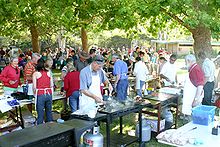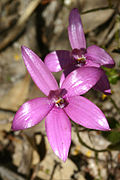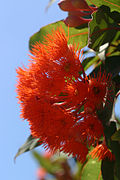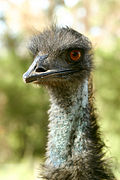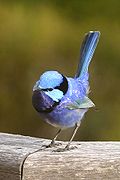Denmark (Australia)
| Denmark | |||||||
|---|---|---|---|---|---|---|---|

|
|||||||
|
|||||||
|
|||||||
|
|||||||
|
|||||||
|
|
|||||||
The place Denmark is 423 km south-south-east of Perth and about 50 kilometers west of Albany on the Southern Ocean in the state of Western Australia .
General
The region Denmark ( Shire of Denmark ) with the place Denmark is located on the southwest coast of Australia. The place is located on the Denmark River of the same name , which flows into the Southern Ocean via the Wilson Inlet . The largest part of the area consists of natural forests with many evergreen hardwood plants. The embedding in near-natural forest and shrub landscapes (so-called bushland ) is characteristic of the settlement areas . In addition, there is agricultural use as pasture land and through fruit and wine growing. In this context, the wood plantations , which are still expanding, must also be listed .
Surrounded by cliffs and dunes, there are exceptionally beautiful beaches on the 100 km long coast. Denmark has a Mediterranean climate with relatively dry summers and wet winters. The average daily temperature in summer is 25 ° C, in winter 16 ° C.
The place Denmark is provided by the central government with its own administration. It was founded in 1895 as a lumberjack settlement. Today agriculture with processing companies, tourism and handicrafts are the economic basis of the Denmark area.
Population and economic foundations
At first, Denmark was a typically rural community. The population subsisted on timber, fruit growing and pasture farming. Viticulture was added later because the climate and soil offer the best conditions for this. The blue gum plantations should also be mentioned in this context . The fast-growing Eucalyptus globulus is mainly processed into wood chips, which are lucratively marketed in Japan, China, India and processed into paper there. The growing tree plantation economy is seen by many as problematic from an ecological point of view.
An agricultural college supports training and further education in the agricultural sector. There is no industry in the narrower sense, only the natural products obtained are processed in medium-sized companies. Denmark does not have a developed port, but commercial fishing has developed on a modest scale.
Above all, however, an efficient tourism industry has increasingly developed over the years. The picturesque coasts with extensive beaches, the quaint and unique forests are popular holiday destinations.
2006 was the last census. The number of inhabitants is growing all the time. In 2008 it was assumed that there were around 5,200 inhabitants. Of this, 1% are descended from indigenous people ( Aborigines ), 70% are descendants of immigrants. 12.3% of today's population came as new immigrants and a. from Great Britain, 1.9% from New Zealand, 1.2% from Germany, 1% from the Netherlands. The population is more or less mixed, shaped by several waves of immigration. We differentiate u. a. the old Denmarkiens of the first waves of immigration, the so-called group settlers (small settlement communities of 10 or 20 families with different religious backgrounds and nationalities), soldier settlers (former soldiers from the First World War who settled as settlers ), people from the newer alternative movement, too “ Hippies ”. Many immigrants came on their own, looked for and found a new home in Australia. In this context, the relatively wealthy retired residents should also be mentioned. So it is to be understood that today's population is quite different in lifestyle and character: pronounced individualists next to residents rooted in religious communities or the alternative scene, people shaped by artistic creation and citizens who rely on modern science.
All of this is also reflected in the diverse cultural activities: art markets, exhibitions, concerts, workshops in local communities. Here, among other things, protection of the native flora and fauna in natural biotopes and environmental protection to preserve the livelihood of people are of particular concern. In this context, it should also be mentioned that in 1998 Denmark received the title of “The Cleanest Community in Australia”.
history
In 1627 the Dutchman François Thijssen discovered the south coast of Australia and named the area of around 1800 km between today's Cape Leeuwin and the Nuyts Archipelago after Pieter Nuyts , who was a senior employee of the Dutch East Indias Companie on board his ship. His name lives on in Nuytsia floribunda with the English name “Western Australian Christmas Tree”.
Two centuries later, when the first whites settled Denmark, the area was inhabited by indigenous people, the Noongar . The clans of these Aborigines lived in southwest Australia at the time. They called the bay with the river Denmark Kurrabup , “the place to come back”. Numerous cultural conflicts of interest with the British settlers and the devastating effects of new infectious diseases led to a drastic decline in the indigenous population. At the beginning of the 20th century, the Noongar disappeared from the Denmark area.
Although the south of Australia was discovered by the Dutch and parts of Western Australia were still marked as Nieuw Holland (German: New Holland) on Dutch maps for a century, the settlement was not made by the Dutch, but by the British. The Dutch concentrated on colonial areas in resource-rich Indonesia. But the British colonized all of Australia in quick succession around 1825 in order to forestall French interests. And with that, Dutch place names such as Nuyts Land, Eendrachtsland, De Wit's Land largely disappeared or were anglicized. Only a few names survived, such as Arnhem Land and Cape Leeuwin .
The river Denmark was only discovered in 1829 by the marine doctor Thomas Braidwood Wilson. Wilson, who assisted him on this expedition, reported, among other things, about soil types and the imposing eucalyptus trees, and named the river after his colleague and friend, the English doctor Alexander Denmark. The name Denmark has nothing to do with Denmark in Europe, which might be obvious if you don't know the history of the discovery, because later many workers immigrated from Scandinavia and were involved in the profitable forestry.
Around 1885, many lease agreements for the use of wood were concluded. In the course of 15 years, the timber industry in Denmark had its peak and the population grew to around 2000 inhabitants during this period. The then newly built railway line from Denmark to Albany was used to transport Karri wood . The wood of these huge eucalyptus trees was of great importance in the construction industry and furniture production at that time. For example, the roof trusses of many houses in England were made of karri wood and even streets in London were paved with it.
But very soon overexploitation led to the collapse of this timber industry. The population sank drastically and only recovered again when immigration campaigns of the so-called Groupsettler movement took hold around 1920. Many small family farms emerged on the cleared area of approx. 40 hectares, but ultimately only made a poor living with pasture farming and fruit growing. Many had to give up again and then earned money. a. living in sawmills. By 1960 the population had grown again to around 1500 residents. Denmark also became attractive to people looking for an alternative lifestyle and to well-funded retirees and early retirees. Winemakers discovered the value of the loamy "Karri" soil, growing Riesling and Chardonnay grapes. And soon other grape varieties were added. So in 50 years Denmark became a wine-growing region of some importance. In 2008 around 25 new vineyards were created.
Tourism began in the Second World War with the stationing of American soldiers in Albany. a. Made trips to Denmark. Souvenirs and restaurants were increasingly in demand. After the war, Denmark became a popular holiday destination for Australians too. The attractive, extensive beaches, the areas with original and unique vegetation, the national parks are ideal for a variety of leisure activities. These are the foundations for further population growth.
Flora and fauna

The place Denmark and the agricultural areas are surrounded by a unique and grandiose forest landscape. The species-rich forest is mainly characterized by eucalyptus trees such as "Marri", "Karri", " Jarrah ", " Red Tingle ".
The "Red Tingles" reach heights of 60 meters. The "Red Flowering Gum" is almost a natural wonder when this eucalyptus species is scarlet in bloom. Thousands of species of wildflowers can be seen, especially in the spring, including orchids . Many of the species are typical of the Denmark area and only grow there.
The bird world is diverse and a. with the cute blue tail, with ibises, flute birds , parrots , the emu . The emu is found throughout Australia outside of densely forested and densely populated areas; Some also kept in farms. Also noticeable are the many reptiles and the marsupials so typical of Australia such as the gray kangaroo , bandicoot and opossum . In the nearby Southern Ocean, whales visit places like Albany and Denmark each year on their way north and dolphins and seals can be seen. And many species of fish live in the water.
The place Denmark
Denmark is located on the South Coast Highway and has an airport for smaller aircraft. Denmark is also connected to other cities by a public bus route.
The location on the Denmark River with the old bridges and the diverse vegetation even in the interior of the village gives the community a very picturesque appearance. Some old buildings date from the pioneering days, for example the wooden Anglican church. The oldest and remaining building is on Strickland Street, the shopping street in the center of town.
Denmark also has a historical museum that illustrates the development of the area with a variety of exhibits.
There is a very old wooden railway bridge near the mouth of the Denmark River. There several hiking trails converge u. a. also the famous Bibbulmun Track, which connects Perth and Albany.
Every 14 days there is a big market in the city center in Denmark on Sundays. Here you will find a wide range of fruit and vegetables from the surrounding area. Craftsmen also offer their work. The holidaymaker experiences the country and its people, local color very directly. But the highlights are the big markets around Christmas and Easter in Berridge Park on the banks of the river Denmark. Here the craftsmen and artists shape the colorful market. People stroll between the stands, buy after careful examination or simply enjoy the diverse and beautiful things. Many sit on the lawn or in pavilions and enjoy the beautiful atmosphere or watch performances.
tourism

In 2007 the municipality of Denmark redesigned the Denmark Visitor Center for visitors. Here guests can find information on reservations and accommodations. Here tourists can get all the important information for round trips to sights, such as visiting national parks. You can get tips for hikes and, above all, get information about the whole area from extensive material and thus be stimulated for activities. Here the visitor also receives information about local products, wineries, restaurants and other shopping opportunities. There is also a wood turner's workshop on site, in which the craftsmanship is demonstrated.
Holidays in a unique landscape: The mild climate, the tranquility, and untouched nature make Denmark an increasingly popular holiday destination for Australians and tourists from distant countries. The population is also constantly increasing. The people find their livelihood here in the growing place. And not only the tourists enjoy the long, pristine beaches on the picturesque coast, the crystal clear waters of the Southern Ocean. The incoming waves are a paradise for surfers. Hiking trails lead nature lovers into a hilly landscape with pristine vegetation, forests with giant trees, and everywhere the hiker sees an abundance of wild flowers, especially in spring.
The environment and in particular the national parks are carefully monitored and maintained through future-oriented moderate interventions, as far as this is necessary at all. For example, on the Tree Top Walk (an observation platform in the treetops) in the Valley of the Giants , the hiker experiences a forest with majestic carribeans and red tingles . The valley is located in the western part of Denmark near Nornalup.
swell
- P. Clarke, A Colonial Woman , Allen & Unwin, 1986.
- I. Conochie, Denmark - An Outline History , Denmark Historical Society, 1990.
- R. McGuinness, A look at Millars and the influence of the railway and tramways on the settlement of the district , Past and Present Intersect and Converge - Denmark through the 1900s.
- RW Mumford, Denmark Western Australia - A History to 1905 .
- G. Sheriff, The History of Denmark , 1951.
- Heritage Trails in the Denmark District - Exploration and Settlement in Tall Timber Country , A Commonwealth / State Bicentennial Project, 1988.
- Notes on the Aborigines of Denmark , Denmark Historical Society, Pamphlet No 1, 2003.
- Koorabup - Special Centenary Issue , Denmark Historical Society, Journal no.21 , 1995.
Web links
- Shire of Denmark (English)
- Denmark Visitor Center - Bookings (English)
- Valley of the Giants Tree Top Walk (English)
- Denmark Historical Museum (English)
Individual evidence
- ↑ Australian Bureau of Statistics : Denmark (Urban Center / Locality) ( English ) In: 2016 Census QuickStats . June 27, 2017. Retrieved April 7, 2020.


